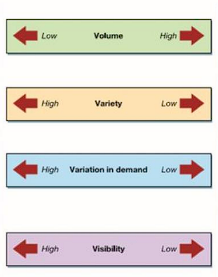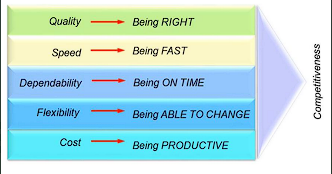
Week 1: Understanding Operations Management

Produces physical products that can be inventoried.
Typically has low customer contact.
Involves capital-intensive processes with long response times.
Offers intangible products that cannot be stored or inventoried.
Requires high customer contact.
Features short response times and is generally more labor-intensive.

High Volume:
Associated with high repeatability, specialization, and capital intensiveness.
Results in low unit costs due to economies of scale.
Low Volume:
Each staff member performs more varied roles, leading to less systematization and higher unit costs.
High Variety:
Operations need to be flexible to match customer needs, which can result in higher unit costs.
Low Variety:
Processes are well-defined and routine, leading to standardization and lower costs.
High Variation in Demand:
Requires changing capacity and flexible anticipation strategies to align with fluctuating demand.
Low Variation in Demand:
Operations can remain stable, predictable, and routine, optimizing resource utilization and minimizing costs.
High Visibility:
Operations need to focus on customer interaction skills due to high customer visibility and expectations.
Low Visibility:
Time lag between production and consumption allows for standardization and centralization, reducing contact skills requirements and unit costs.

Focuses on the accuracy and high standards of the output, ensuring that the product or service meets the set specifications and customer expectations.
Emphasizes quick processing and response times, reducing the duration from order to delivery, which can significantly enhance customer satisfaction.
Relates to the reliability of the operation in delivering products or services when they are promised, thus maintaining trust and dependability with customers.
The ability of the operation to adapt to changes, whether they are in product design, process adjustments, or variations in product or service demand.
Involves managing and optimizing costs to achieve high productivity, enabling competitive pricing while maintaining profitability.

Produces physical products that can be inventoried.
Typically has low customer contact.
Involves capital-intensive processes with long response times.
Offers intangible products that cannot be stored or inventoried.
Requires high customer contact.
Features short response times and is generally more labor-intensive.

High Volume:
Associated with high repeatability, specialization, and capital intensiveness.
Results in low unit costs due to economies of scale.
Low Volume:
Each staff member performs more varied roles, leading to less systematization and higher unit costs.
High Variety:
Operations need to be flexible to match customer needs, which can result in higher unit costs.
Low Variety:
Processes are well-defined and routine, leading to standardization and lower costs.
High Variation in Demand:
Requires changing capacity and flexible anticipation strategies to align with fluctuating demand.
Low Variation in Demand:
Operations can remain stable, predictable, and routine, optimizing resource utilization and minimizing costs.
High Visibility:
Operations need to focus on customer interaction skills due to high customer visibility and expectations.
Low Visibility:
Time lag between production and consumption allows for standardization and centralization, reducing contact skills requirements and unit costs.

Focuses on the accuracy and high standards of the output, ensuring that the product or service meets the set specifications and customer expectations.
Emphasizes quick processing and response times, reducing the duration from order to delivery, which can significantly enhance customer satisfaction.
Relates to the reliability of the operation in delivering products or services when they are promised, thus maintaining trust and dependability with customers.
The ability of the operation to adapt to changes, whether they are in product design, process adjustments, or variations in product or service demand.
Involves managing and optimizing costs to achieve high productivity, enabling competitive pricing while maintaining profitability.